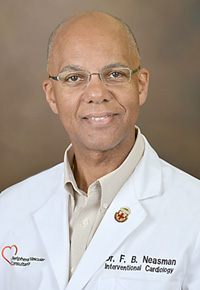- La Feria Community Holds Succesful Business Mixer Event
- Little Nashville to Take Place in Downtown Mercedes
- Lions Basketball Captures District Gold
- La Feria ISD Students Compete in Regional Chess Tournament
- Lions End First Half of 32-4A on a High Note
- La Feria ISD Held Another Successful Parent Conference
- Strong Appearance for Lions at Hidalgo Power Meet
- LFECHS Students Get to Meet Local Actress
- Students Participate in Marine Biology Camp
- Two LFECHS Students Qualify for All-State Band
Treatment Available for Pain from Walking
- Updated: August 28, 2015


Dr. Farley Neasman, Interventional Cardiologist
HARLINGEN – For some Valley residents, just walking or standing can be painful. In some cases, this pain may be caused by blockages in the blood vessels in the legs – and treatment is available which could potentially help save the person’s life or a limb.
Dr. Farley Neasman, Interventional Cardiologist, recently spoke on “Can’t Stand the Pain of Standing” to more than 120 people at Valley Baptist Medical Center in Harlingen. Dr. Neasman said patients who have pain or discomfort when walking should be checked for blockages in the legs — if their type of pain stops when they stop walking.
“In these patients, in order to make the discomfort in their legs go away, the person has to stop walking,” Dr. Neasman said. “That should be considered a blockage, unless proven otherwise.”
Dr. Neasman distinguished this type of pain, when walking, from a person who feels painful cramps at night when in bed. Those cramps are NOT caused by blockages in the blood vessels, he said.
“Symptoms of blockages, or peripheral artery disease, do include dull cramping or pain in the muscles of hips, thighs, or calf muscles when walking, climbing stairs, or exercise, which is relieved with cessation of that activity,” Dr. Neasman said.
Other possible symptoms of blockages may include fatigue in the legs which requires the patient to stop and rest while walking; walking with a slow or shuffled gait; and having difficulty keeping up with others while walking.
If a patient is diagnosed with peripheral artery disease, Dr. Neasman said it is critical that he or she be treated. Early treatment can save the patient from later having to get their leg amputated – or possibly having a heart attack or “brain attack” (stroke) in the future, he said.
At Valley Baptist, cardiologists have several ways to open blocked blood vessels in the the legs, including tiny balloons which are inserted into the artery through a thin tube or “catheter”; a device to cut out build-ups of substances such as cholesterol and calcium inside the walls of arteries; a laser which vaporizes “plaque” in the blood vessel; and a ‘sanding device’ to gently sand away hardened plaque and calcium inside the blood vessels. In addition, the physician may insert a tiny metallic device, called a stent, which helps hold the wall of the blood vessel open.
For more information on treatment of peripheral artery disease, consult your physician and visit www.ValleyBaptist.net.


